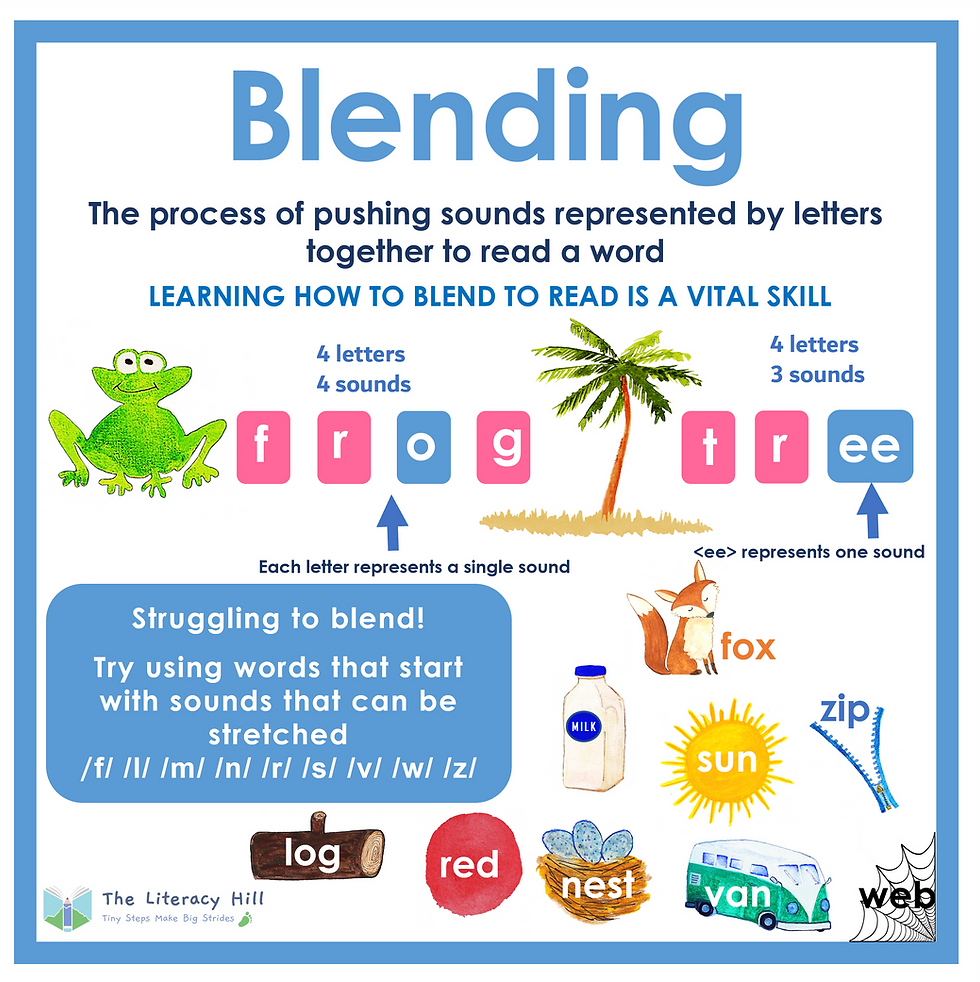WE BLEND ORAL SOUNDS TO MAKE WORDS
- Nov 3, 2018
- 4 min read
Updated: Feb 20, 2024

We blend oral sounds together when we speak to create words. We speak millions of words in conversations across the globe. Speech comes naturally to nearly everyone. Reading, on the other hand, is not so easy.
The term blends has been around for a long time. I remember blends from my school days. This term is used to describe adjacent consonant sounds — two consonants that sit together are also called consonant clusters by speech pathologists who work on articulation problems with children.
As Carmen McGuinness states in Reading Reflex:
“Readers blend all sounds in a word as they read, not just the adjacent consonant sounds.”
Blending is the process of pushing sounds together to form words. It is vital that children can blend sounds in their own speech before moving on to segment and blend the sounds of unfamiliar words on a page.
Blends are often confused with digraphs. A digraph is two letters that represent a single sound. There are consonant digraphs and vowel digraphs. Often the letters represent a completely new sound, not the initial sounds together.
c and h go together to create /ch/ as in chips
s and h go together to create/sh/ as in ship
o and i go together to create /oi/ as in oil
In a blend, we can distinctly hear the two initial sounds, lamp, frog, and gift.
Here is the problem, we can sound out frog, lamp, and gift using initial sounds. So why confuse matters and teach blends as a unit of sound. Let’s take the word frog as an example, f r o g from a phoneme point of view, the word has four sounds that correspond to 4 letters. The F and the R are independent of each other. The F and the R don’t go together to represent a new sound. They represent their initial sounds /f/ and /r/. Teaching them as the blend FR is an unnecessary step and often causes confusion.

All children need to start with the smallest unit of oral sound (phoneme) and build on from there. Segmenting words into individual sounds and blending the sounds together to form the word is a key skill for fluency. It is a skill that needs teaching. Often children don’t pick this up on their own.
Here are other examples with consonant clusters and vowel digraphs,
The word blue has 4 letters and 3 sounds /b/ /l/ /ue/
The /b/ and the /l/ are separate sounds. The /b/ sound is first and the /l/ is second. The u and e go together as one vowel digraph the /oo/ sound and is the end sound.
The word cream has 5 letters and 4 sounds /c/ /r/ /ea/ /m/
The /c/ and the /r/ are separate sounds. The /ea/ go together as 1 vowel digraph the /ee/ sound and /m/ is the last sound.
Beginning readers must learn to automatically link letters to sounds. Word building systematically develops the skill of segmenting as children sound out words as they move the pieces of the jigsaw to create a word.
When we teach how to read the word back, we teach the skill of blending to read. Word building is a playful activity that integrates the learning of initial sounds, phoneme awareness and letter knowledge. Integration, not isolation, helps students develop the skills to become automatic when reading.
In the beginning, children can't possibly know how the whole alphabet system works.
Systematic literacy instruction that teaches all children how to decode and gives students an awareness of how sounds and letters work together must go hand in hand with incidental discussions about unknown words, their meaning, and definitions to build vocabulary. This explicit and implicit instruction will highlight the complexities of our language, and through this process, all children can flourish.
Talking is automatic, and speech sounds are not something you think about unless there is a problem. The only time you think about sounds and letters as an adult is when you can’t read or spell a word and revert to sounding it out. If you are the parent of a dinosaur lover, you can often find yourself sounding out many words.
Some children have trouble blending sounds to create words.
Many students get to the point of blending to read CVC words but need help going beyond to get to CVCC and CCVC. We have to help students get the words off the page. To do this, they need lots of repetition. Starting with consonants that can be stretched can help get over the CVCC, CCVC hump!
If this happens to your little one, try starting with continuant consonants. Don’t know what they are? Read on to find out!
We can stretch continuant consonant sounds, and this gives your little one more time to hear the sounds. Try it — ssssss u n starting with sounds that stretch can have a big effect if your child struggles to blend sounds. Now say — pan. Can you notice the difference? So words such as, sat, sit, mat, man, run, sun, zip are all great words to start your little learner off.

There is also research to back up this strategy. Gonzalez-Frey and Ehri (2020) demonstrated in their paper that connected phonation is more effective in the beginning than segmented phonation.
Surely, we want to teach all young children to read, write, and spell in the most effective way possible that limits confusion and quickly develops strong literacy skills.
Writing is an invented system, so approaching reading, writing, and spelling from a speech to print point of view helps all children to gain ground quickly.
If you have enjoyed this post, please share and pin it for later.
The original sketch note.







Comments